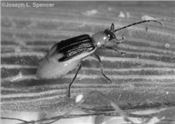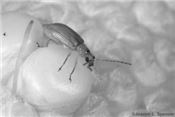|
Managing Corn Rootworm Populations In Illinois: Considerations For 2018
DR. NICK SEITER, DR. JOE SPENCER, AND KELLY ESTES
URBANA, ILL.
Rootworm management is a yearly consideration for most corn producers in central and northern Illinois. Western corn rootworm (Fig. 1) is the primary pest species throughout most of the state, but areas in northern IL can experience pest pressure from the northern corn rootworm (Fig. 2) as well. Adult population densities have been low in recent years compared with historical averages, although they did creep up a bit in 2017. The overall reduction in corn rootworm pressure is likely due to a combination of unfavorable weather (or at least unfavorable to rootworm larvae) and widespread adoption of corn hybrids expressing combinations of Bt toxins for rootworm control.
Over the last few years, western corn rootworm populations with resistance to Cry3Bb1 and mCry3A (two commonly expressed toxins in Bt corn hybrids) have been documented in Illinois. Research published in 2016 on Iowa1 and Minnesota2 western corn rootworm populations showed that resistance to these toxins also confers resistance to the structurally-similar eCry3.1Ab toxin. Cross-resistance among these “Cry3” Bt toxins should be expected for Illinois western corn rootworm populations. Resistance to pest control practices in the western corn rootworm is nothing new; this insect is notorious for developing resistance to control tactics such as insecticides and crop rotation. Part of the concern with these recent developments is that there are relatively few Bt toxins available to combat corn rootworm. Furthermore, all available hybrids with pyramided traits for corn rootworm use either Cry3Bb1 or mCry3A in combination with a second toxin (either Cry34/35Ab1 or eCry3.1Ab). This means that, where resistance is present in the population, there might in fact be at best only one effective toxin at work. (If you have trouble keeping all of these toxins straight, a good resource is the “Handy Bt Trait Table” produced by Dr. Chris DiFonzo at Michigan State University: https://www.texasinsects.org/bt-corn-trait-table.html).
There are steps producers can take to manage corn rootworm and hopefully slow the further development of resistance. The best way to delay resistance to any control tactic is to reduce exposure of the target insect to that tactic in the environment. Specific ways to accomplish this with Bt toxins include:
• Apply rootworm control (whether in the form of a Bt hybrid or a soil insecticide) only where it is economically justified based on sampling rootworm adults the previous year. If you monitor using a yellow sticky trap, the economic threshold is 2 rootworm beetles per trap per day in corn following corn. For rotated corn, the economic threshold is 1.5 western corn rootworm beetles per trap per day in soybean3. (These thresholds are based on a recent study in Iowa, which recalculated economic thresholds for corn rootworm based on updated crop values and control costs3).
• Rotating corn with soybean or another non-host crop remains an effective management strategy in the southern portion of the state. While crop rotation is no longer a reliable method to protect first-year corn from western corn rootworm damage in central and northern Illinois, all larvae that hatch into soybean still die, and every acre planted to soybean is an acre where larvae are not being exposed to Bt toxins or soil insecticides.
• Where monitoring indicates that control is justified in corn, rotate the control measures used from year to year. This means rotating among Bt hybrids with different trait combinations and non-Bt hybrids treated with a soil insecticide.
• Follow all refuge requirements for any Bt corn hybrids you plant. In many cases, the “refuge in a bag” or “RIB” approach is now used, but check with your seed distributor on specific requirements for your hybrids.
Finally, an important step is to monitor the performance of your control methods. While lodging is often the cue we look out for to identify rootworm damage, keep in mind that (1) corn can take a lot of damage without lodging depending on soil type and weather conditions and (2) plenty of factors other than rootworm damage can lead plants to lodge. The best approach to evaluating rootworm damage is to dig a representative sample of roots in late July and evaluate them for feeding damage: unpleasant work, but necessary if we want to understand the true extent of the damage. Consider planting a small area or a portion of a row with a non-Bt/untreated hybrid as a check strip. Having an untreated patch in your field will allow you to compare the efficacy of your management tactic vs. the background level of damage where no rootworm protection was used. Finally, if you experience greater damage than expected in Bt corn hybrids in 2018, please let us know at the email address below; your reports will help us to document the status of resistance in Illinois and provide updated information to producers. ∆
DR. NICK SEITER: Research Assistant Professor, Field Crop Entomologist, University of Illinois
DR. JOE SPENCER: Principal Research Scientist and Research Program Leader in Insect Behavior, University of Illinois
KELLY ESTES: Agricultural Pest Survey Coordinator, University of Illinois
1Jakka, S.R.K., et al. Scientific Reports 6: 27860. DOI: 10.1038/srep27860
2Zukoff, S. N. et al. 2016. Journal of Economic Entomology 109: 1387-1398. DOI: 10.1093/jee/tow073
3Dunbar, M. W. and Gassmann, A. J. 2013. Journal of Economic Entomology 106: 168-180. DOI: 10.1603/EC11291

Fig. 1. Western corn rootworm adult.
Photos courtesy of J. Spencer

Fig. 2. Northern corn rootworm adult.
|
|